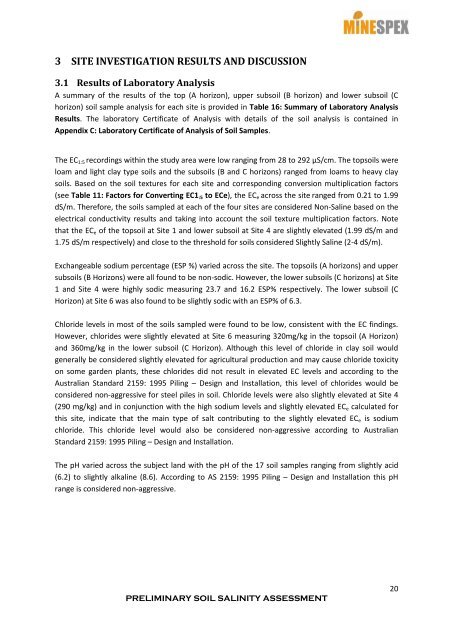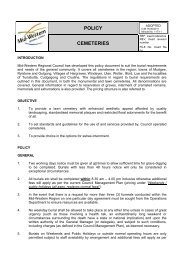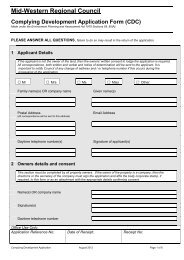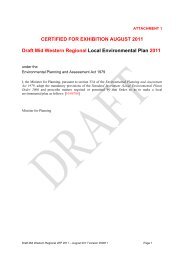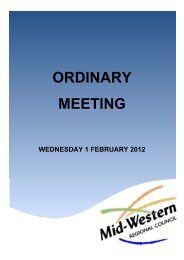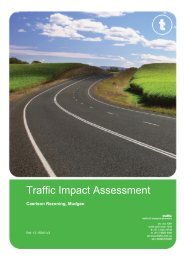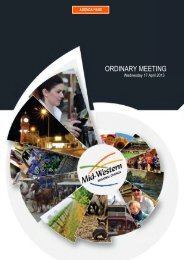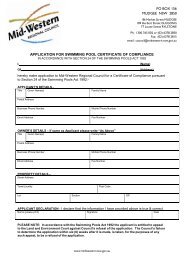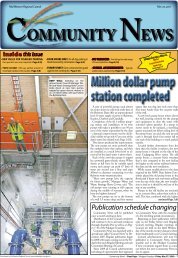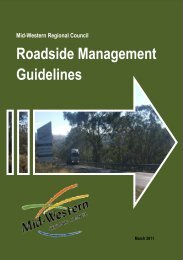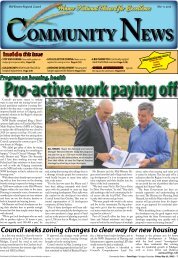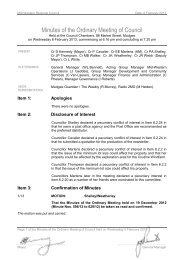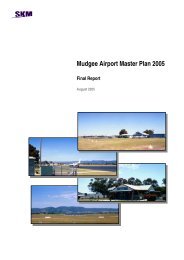preliminary soil salinity assessment - Mid Western Regional Council
preliminary soil salinity assessment - Mid Western Regional Council
preliminary soil salinity assessment - Mid Western Regional Council
You also want an ePaper? Increase the reach of your titles
YUMPU automatically turns print PDFs into web optimized ePapers that Google loves.
3 SITE INVESTIGATION RESULTS AND DISCUSSION3.1 Results of Laboratory AnalysisA summary of the results of the top (A horizon), upper sub<strong>soil</strong> (B horizon) and lower sub<strong>soil</strong> (Chorizon) <strong>soil</strong> sample analysis for each site is provided in Table 16: Summary of Laboratory AnalysisResults. The laboratory Certificate of Analysis with details of the <strong>soil</strong> analysis is contained inAppendix C: Laboratory Certificate of Analysis of Soil Samples.The EC 1:5 recordings within the study area were low ranging from 28 to 292 µS/cm. The top<strong>soil</strong>s wereloam and light clay type <strong>soil</strong>s and the sub<strong>soil</strong>s (B and C horizons) ranged from loams to heavy clay<strong>soil</strong>s. Based on the <strong>soil</strong> textures for each site and corresponding conversion multiplication factors(see Table 11: Factors for Converting EC1 :5 to ECe), the EC e across the site ranged from 0.21 to 1.99dS/m. Therefore, the <strong>soil</strong>s sampled at each of the four sites are considered Non-Saline based on theelectrical conductivity results and taking into account the <strong>soil</strong> texture multiplication factors. Notethat the EC e of the top<strong>soil</strong> at Site 1 and lower sub<strong>soil</strong> at Site 4 are slightly elevated (1.99 dS/m and1.75 dS/m respectively) and close to the threshold for <strong>soil</strong>s considered Slightly Saline (2-4 dS/m).Exchangeable sodium percentage (ESP %) varied across the site. The top<strong>soil</strong>s (A horizons) and uppersub<strong>soil</strong>s (B Horizons) were all found to be non-sodic. However, the lower sub<strong>soil</strong>s (C horizons) at Site1 and Site 4 were highly sodic measuring 23.7 and 16.2 ESP% respectively. The lower sub<strong>soil</strong> (CHorizon) at Site 6 was also found to be slightly sodic with an ESP% of 6.3.Chloride levels in most of the <strong>soil</strong>s sampled were found to be low, consistent with the EC findings.However, chlorides were slightly elevated at Site 6 measuring 320mg/kg in the top<strong>soil</strong> (A Horizon)and 360mg/kg in the lower sub<strong>soil</strong> (C Horizon). Although this level of chloride in clay <strong>soil</strong> wouldgenerally be considered slightly elevated for agricultural production and may cause chloride toxicityon some garden plants, these chlorides did not result in elevated EC levels and according to theAustralian Standard 2159: 1995 Piling – Design and Installation, this level of chlorides would beconsidered non-aggressive for steel piles in <strong>soil</strong>. Chloride levels were also slightly elevated at Site 4(290 mg/kg) and in conjunction with the high sodium levels and slightly elevated EC e calculated forthis site, indicate that the main type of salt contributing to the slightly elevated EC e is sodiumchloride. This chloride level would also be considered non-aggressive according to AustralianStandard 2159: 1995 Piling – Design and Installation.The pH varied across the subject land with the pH of the 17 <strong>soil</strong> samples ranging from slightly acid(6.2) to slightly alkaline (8.6). According to AS 2159: 1995 Piling – Design and Installation this pHrange is considered non-aggressive.PRELIMINARY SOIL SALINITY ASSESSMENT20


